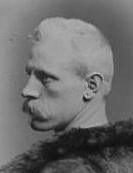Fridtjof Nansen
|
|
Fridtjof Nansen (born October 10, 1861 in Kristiania Oslo - died May 13, 1930 in Oslo) was a Norwegian explorer, scientist and diplomat. Nansen was awarded the Nobel Peace Prize in 1922 for his work as a League of Nations High Commissioner.
| Contents |
Arctic exploring
Nansen made his first voyage to Greenland waters in a sealing ship 1882, and in 1888 succeeded in crossing the Greenland icefield on skis from East to West together with Otto Sverdrup, Olaf Dietrichson, Kristian Kristiansen Trana, Samuel Balto and Ole Nielsen Ravna. In 1893, he sailed to the Arctic in the Fram (a purpose-built, round-hulled ship later used by Roald Amundsen to transport his expedition to the Antarctica,) which was deliberately allowed to drift north through the ice, a journey that took more than three years. During this first crossing of the Arctic Ocean the expedition became the first to discover the existence of a deep polar basin. When it after more than one year in the ice became apparent that Fram would not reach the North Pole, Nansen, accompanied by Hjalmar Johansen (1867-1913), continued north on foot and, in April 1895, reached 86° 14´ N, the highest latitude then attained. The two men were forced to spend the winter, surviving on walrus blubber and polar bear meat, on Franz Josef Land, where they eventually, in the summer of 1896, connected with a British expedition led by Frederick George Jackson.
Academic career and scientific works
Nansen was a professor of zoology and later oceanography at the Royal Frederick University in Oslo and contributed with ground breaking works in the fields of neurology and fluid dynamics. He was one of the founders of the neuron theory stating that the neural network consists of individual cells communicating with each other. Nansen also did extensive research into the behavior and origin of ocean currents, following his experiences from the Fram-expedition. He was, together with the Swedish mathematician V. Walfrid Ekman, deeply involved in the discovery of how currents are generated from the planetary rotation and the formulation of the theory of the Ekman spiral that explains the phenomenom.
Diplomatic and political career
Before Norway's dissolution of its union with Sweden on 7 June 1905, Nansen had been a devoted republican, together with other prominent Norwegians like the authors Bjørnstjerne Bjørnson and Arne Garborg. However, after convincing argumenting by Sigurd Ibsen and others, Nansen changed his position (as did Bjørnson and Garborg) and was thereafter influential in convincing Prince Charles of Denmark that he should accept the position as king of Norway. Prince Charles was eventually crowned after a referendum where the Norwegians voted for a monarchy. Nansen campaigned for this result, certain it was the right thing for Norway, although the general view was that he would be elected President in an alternative republic.
Following Norway's independence Nansen was appointed as the Norwegian ambassador in London (1906-08) becoming a close friend of King Edward and assuring support from Britain in the campaign for an international guarantee of Norwegian territorial integrity.
In the period between the wars there was an unsuccessful effort on Nansen's behalf to make him the Prime Minister in a broad government based on all the non-socialist parties to counter the growth of Arbeiderpartiet, the Norwegian labour party. In 1925 he co-founded Fedrelandslaget (The Fatherland Society), an anti-socialist political organisation that folded at the outbreak of the Second World War.
The League of Nations
After World War I, Nansen became involved in the League of Nations as a High Commissioner for several initatives, including organisation of exchange of war prisoners and help to Russian refugees, in which campaign he originated the Nansen passport for refugees. For his work in service of the League of Nations he was awarded the Nobel Peace Prize in 1922.
In honor of the Nobel Peace Prize Laureate Fridtjof Nansen, the Royal Norwegian Navy has named the Fridtjof Nansen class of frigates, and the lead ship, HNoMS Fridtjof Nansen after him.
References
- Nansen, F. (1999). Farthest North. New York: Modern Library. (English translation of Nansen's own account of the Fram journey.)
- Huntford, Roland. (1997). Nansen. London: Gerald Duckworth & Co.
External links
- The Fridtjof Nansen Institute (http://www.fni.no/)
- Nobel Prize biography (http://www.nobel.se/peace/laureates/1922/nansen-bio.html)
- Short Nansen Biography (http://www.nrsc.no/nansen/fritjof_nansen.html)
- Nansen page w/pictures (http://www.xs4all.nl/~pal/nansen.htm)
- Moledet Party of Israel models Elon Peace Plan after Nansen's work with Turkey and Greece (http://www.moledet.org/nobel.html)
- Fridtjof Nansen (http://www.mnc.net/norway/Nansen.htm)
- Nobel Peace Prize laureate Fridtjof Nansen (http://nobelprize.org/peace/laureates/1922/)da:Fridtjof Nansen
de:Fridtjof Nansen et:Fridtjof Nansen es:Fridtjof Nansen eo:Fridtjof NANSEN fr:Fridtjof Nansen he:פריטיוף ננסן hu:Fridtjof Nansen nl:Fridtjof Nansen ja:フリチョフ・ナンセン nb:Fridtjof Nansen nn:Fridtjof Nansen pl:Fridtjöf Nansen sl:Fridtjof Nansen fi:Fridtjof Nansen sv:Fridtjof Nansen

